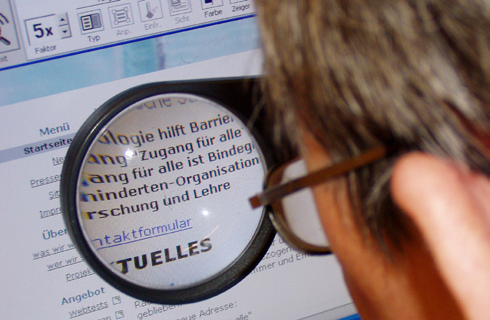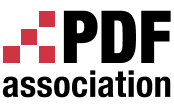PDF/UA
ISO 14289: The new standard for universally accessible PDF documents and forms

Photo © 2009 by Jake Davies · ojisanjake.blogspot.de
-
•When is a PDF universally accessible?
-
•What should PDF developers know?
-
•Where does PDF/UA make a difference?

PDF Association · www.pdfa.org
What is PDF/UA?
PDF/UA is the common name for ISO 14289. An international standard approved in 2012, PDF/UA defines how to represent electronic documents in the PDF format in a manner that al lows the file to be accessible. The standard identifies PDF components and properties relevant to this objective and provides requirements and restrictions on the form of their use.
PDF was not originally designed for accessibility; the focus was on providing accurate and reliable on-screen and printed results for page-based content. In 2000 the PDF specification was extended by a mechanism called “tagging” to make it possible to add structure and semantics to page content. PDF/UA defines the correct use of PDF tagging for maximum accessibility.
In parallel with W3C’s Web Content Accessibility Guidelines (WCAG 2.0) project, AIIM and Adobe Systems started the PDF/UA Committee in 2004 to explore and develop specific technical requirements for accessible PDF. Following the ISO standardization of PDF in 2008, the working document was redrafted to use ISO 32000 and PDF/UA began development towards publication as an ISO standard. In 2010, PDF/UA was accepted as an ISO New Work Item. In 2012, PDF/UA publishes as ISO 14289.
PDF/UA makes the world a better place
-
•Increases likelihood that content provided in the PDF format is more accessible to more people than ever before
-
•Establishes the technical requirements necessary to encourage development of accessible PDF creation and reading software
-
•Provides an International Standard to guide software procure ment and development
-
•Provides a technically-specific road-map to conformance with WCAG 2.0 in PDF content
-
•Reduces liability exposure and minimizes legal uncertainty
-
•Enables high quality, reliable reuse and re-purposing of PDFs
-
•Implies eligibility for the “A” conformance level of PDF/A, the widely adopted ISO standard for PDF based archiving
Why does the world need PDF/UA?
Tagged PDF first entered the market well over a decade ago. Why do we need an ISO standard for this PDF feature?
PDF is highly capable but internally complex. Regarding tagging and content reuse, the core PDF language includes significant ambiguities that have led to confusion and re duced interoperability. Market pressure for a reliable content accessibility and reuse mechanism for PDF content has been building for years, but key public-sector regulations to-date have tended to provide guidance in HTML and web-specific terms, leaving implementers without clear guidance on how to ensure the PDF files they create are made both reliable and accessible in the assistive technology context.
For these and other reasons high-quality tagged PDF has been slow to find broad acceptance. Today, over 70% of PDFs pro duced on desktop computers are still completely untagged, while those PDFs that are tagged are frequently substandard. As a consequence, most users who rely on tags in PDF to read have learned to dislike PDF files for the unreliable, disjointed and grossly unsatisfactory experience they’ve so often received.
PDF/UA delivers enhanced communications to persons with disabilities
PDF/UA will offer demonstrable high-quality results to end-us ers with disabilities using readily-available PDF/UA conforming (and near-conforming) readers and assistive technology.
It is to be expected that the PDF/UA standard will soon be referenced by equal access legislation and policies in Europe, North America and elsewhere, whether for government agen cies, public procurement regulations or organizations in the private sector.
PDF/UA will quickly become an indispensable building block for any comprehensive organization-wide strategy to ensure documents and forms conform with applicable accessibility regulations, reducing liability exposure.
PDF/UA is a reality. What are you going to do about it?
PDF/UA is coming soon, and there’s something for everyone:
-
•Authoring software used to create PDF files, including OCR software, office programs and publishing tools
-
•Editing software used to modify or tag existing PDF files
-
•Reader software used to process a PDF file for use in a viewer or other consumer implementation
-
•Assistive Technology software used interactively with PDF readers to provide access to users with disabilities
PDF/UA may soon be a requirement – or a “suggestion” – for your organization or its customers. It’s time to know more.
How can we help?
Members and non-members alike will always find the PDF Association website, www.pdfa.org , a good place to start. The organization has made available video recordings and slides of technical presentations regarding PDF/UA from the PDF Association’s 2012 Technical Conference. Members of the PDF Association benefit from a network of renowned experts, extensive internal resources and active collaboration in the PDF/UA Competence Center.

Creating PDF/UA
An assertion of PDF/UA conformance places stringent demands on both document authoring software and the author responsible for the conformance status of a particular document. In PDF, text strings of arbitrary lengths may occur in almost any content stream for a wide variety of more-or- less unfortunate reasons. Developers can take very little for granted, but PDF/UA ensures a focus on what matters for accessibility purposes. PDF/UA makes it possible to deliver accessible content with the reliability that is a hallmark of PDF.
To comply with PDF/UA, all content on the PDF page must be correctly categorized as artifact or real content. All real con tent must then be correctly characterized in semantic terms and a tags tree provided, to indicate the logical reading order of the document.
High quality input PDF files are required, including several specific technical requirements for font embedding and character encoding, among other requirements.
Using PDF/UA
Conformance with ISO 14289 enables a top-quality reading and navigating experience with all types of conforming assistive technology. Organizations can use PDF/UA as part of their overall strategy to comply with applicable accessibility laws, regulations or best practices. PDF/UA enables…
-
•Access to content in a structured, logical reading order complete with applicable semantics
-
•High-quality results when accessing PDF content on mobile devices, smart-phones, e-readers and tablet PCs
-
•Text reuse (copy & paste, automated content extraction)
-
•Enhanced search results
Consumers of PDF/UA conforming PDF files include PDF readers, screen readers, magnification and text re-flow tools, Braille printers, text-to-speech (TTS) systems, content reuse and re-purposing implementations as well as search engines.
The PDF/UA Competence Center
Within the PDF Association, accessibility experts, PDF developers and supporters of PDF/UA work together in the PDF/UA Competence Center to discuss strategies, develop educational material and research technical implementation details. We identify opportunities to speak at conferences and organize webinars or in-person-events to educate developers, policy makers and end users about PDF/UA.
Join the PDF/UA Competence Center!
If your organization is already a member of the PDF Association, consider joining the conversation and activities in the PDF Association’s PDF/UA Competence Center – just send an email to info@pdfa.org for more information or to sign up right away.
If your organization cannot become a member of the PDF Association you may still join as an individual and become part of the PDF/UA Competence Center’s meetings, discussions, public events and development efforts. Again, just send an email to info@pdfa.org for more information.
Membership in the PDF Association
Founded in 2006, the PDF Association exists to promote the adoption and implementation of International Standards for PDF technology. The activities of the PDF Association cover the PDF standard itself as well as PDF/A, PDF/E, PDF/UA, PDF/VT and PDF/X. We work closely with ISO on the develop ment of future PDF standards. If you wish to participate in the most influential association for PDF to shape what PDF will look like in the future, please get in touch:

Association for Digital Document
Standards e.V.
– PDF Association –
Neue Kantstraße 14
14057 Berlin
Tel: +49 30 39 40 50-0 · Fax: +49 30 39 40 50-99 www.pdfa.org · info@pdfa.org · Registered in: Berlin, District Court of Berlin-Charlottenburg, VR 26099 B · VAT ID: DE251189066